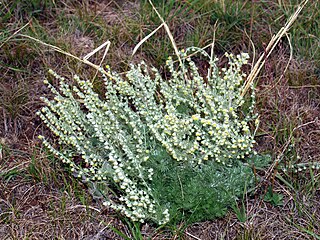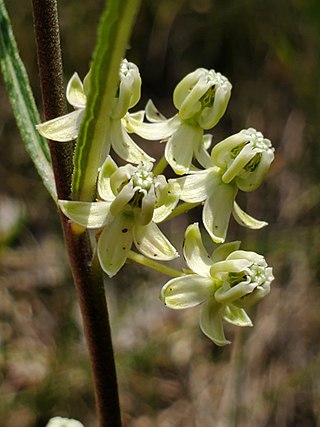
Asclepias tuberosa, commonly known as butterfly weed, is a species of milkweed native to eastern and southwestern North America. It is commonly known as butterfly weed because of the butterflies that are attracted to the plant by its color and its copious production of nectar.

Asclepias incarnata, the swamp milkweed, rose milkweed, rose milkflower, swamp silkweed, or white Indian hemp, is a herbaceous perennial plant species native to North America. It grows in damp through wet soils and also is cultivated as a garden plant for its flowers, which attract butterflies and other pollinators with nectar. Like most other milkweeds, it has latex containing toxic chemicals, a characteristic that repels insects and other herbivorous animals.

Liatris aspera is a perennial wildflower in the Asteraceae family that is found in central to eastern North America in habitats that range from mesic to dry prairie and dry savanna.

Asclepias curassavica, commonly known as tropical milkweed, is a flowering plant species of the milkweed genus, Asclepias. It is native to the American tropics and has a pantropical distribution as an introduced species. Other common names include bloodflower or blood flower, cotton bush, hierba de la cucaracha, Mexican butterfly weed, redhead, scarlet milkweed, and wild ipecacuanha.

Liatris pycnostachya, the prairie blazing star, cattail gayfeather, Kansas gayfeather, or cattail blazing star, is a perennial plant in the Asteraceae family that is native to the tallgrass prairies of the central United States.

Asclepias verticillata, the whorled milkweed, eastern whorled milkweed, or horsetail milkweed, is a species of milkweed native to most of eastern North America and parts of western Canada and the United States.

Asclepias fascicularis is a species of milkweed known by the common names narrowleaf milkweed and Mexican whorled milkweed. It is a perennial herb that grows in a variety of habitats.

Asclepias meadii is a rare species of milkweed known by the common name Mead's milkweed. It is native to the American Midwest, where it was probably once quite widespread in the tallgrass prairie. Today much of the Midwest has been fragmented and claimed for agriculture, and the remaining prairie habitat is degraded.

Liatris punctata is a species of flowering plant in the family Asteraceae known by the common names dotted gayfeather, dotted blazingstar, and narrow-leaved blazingstar. It is native to North America, where it occurs throughout the plains of central Canada, the central United States, and northern Mexico.

Artemisia frigida is a widespread species of flowering plant in the aster family, which is known as the sunflower family. It is native to Europe, Asia, and much of North America. In parts of the north-central and northeastern United States it is an introduced species.

Asclepias quadrifolia, commonly called four-leaved milkweed or fourleaf milkweed, is a species of milkweed in the Apocynaceae (dogbane) family. It is sometimes referred to as whorled milkweed, but it should not be confused with Asclepias verticillata. A. quadrifolia occurs in the eastern United States and Canada.

Asclepias lanceolata, the fewflower milkweed, is a species of milkweed that is native to the coastal plain of the United States from New Jersey to Florida and Southeast Texas. A. lanceolata is an upright, perennial plant that can grow between 3 and 5 feet tall, with red-orange flowers blooming in the summer months. It can also be referred to as Cedar Hill milkweed, as it was first described by Dr. Eli Ives in the neighborhood of Cedar Hill in New Haven, Connecticut.

Asclepias sullivantii is a species of flowering plant in the milkweed genus, Asclepias. Common names include prairie milkweed, Sullivant's milkweed, and smooth milkweed. It is native to North America, where it occurs in the central United States and Ontario in Canada.

Asclepias viridiflora, is commonly known as green comet milkweed, green-flower milkweed, and green milkweed. It is a widely distributed species of milkweed (Asclepias), known from much of the eastern and central United States from Connecticut to Georgia to Arizona to Montana, as well as southern Canada and northern Mexico. The Latin specific epithet viridiflora means green-flowered.

Asclepias variegata, commonly called the redring milkweed or white milkweed, is a plant in the family Apocynaceae. It is native to eastern North America, where it is found in Canada and the United States. It is most common in the Southeastern United States, and becomes rare in the northern edge of its range.

Asclepias stenophylla is a species of flowering plant in the dogbane family (Apocynaceae) commonly called slimleaf milkweed and narrow-leaved green milkweed.

Asclepias angustifolia, commonly called the Arizona milkweed, is an endemic species of milkweed native only to Arizona.

Asclepias perennis, also known as aquatic milkweed or white swamp milkweed, is a North American species of milkweed that is found throughout the Coastal Plain from eastern Texas to southern South Carolina, northward along the Mississippi River, and into the Ohio Valley of Illinois, Indiana, and Kentucky. There seems to be a few disjunct populations in Arkansas, Texas, and Indiana.

Thaspium trifoliatum, commonly called meadow-parsnip or purple meadow-parsnip is a species of flowering plant in the carrot family (Apiaceae). It is native to eastern North America where it is found in many eastern U.S states and in Ontario, Canada. It has a broad natural habitat, which includes mesic to dry forests and woodlands, prairies, bluffs, and rock outcrops.

Asclepias cinerea, also known as Carolina milkweed or ashy milkweed, is a herbaceous perennial plant species in the genus Asclepias. It is native to the United States where its range is concentrated in the Southeast.





















